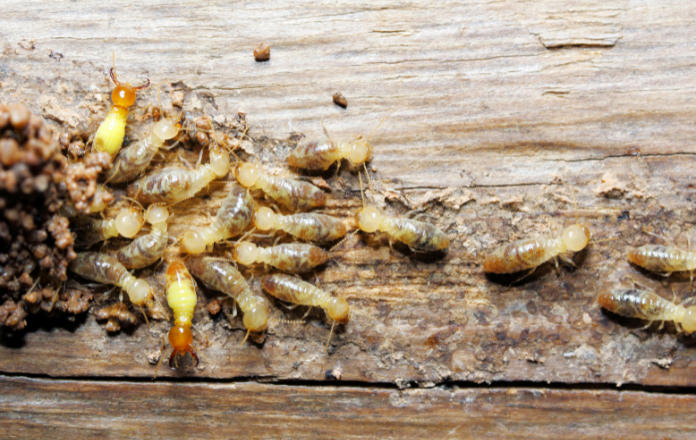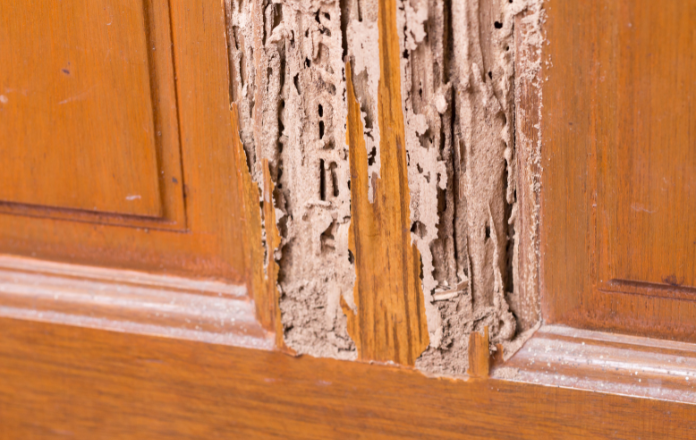
Drywood Termites: How To Identify, Prevent & Treat Infestations
One of the downsides of owning a piece of wood furniture is its vulnerability to termites. These insects burrow their way through wood and gradually eat away at it.
If left undetected, termites can cause significant damage to your furniture, making it necessary to replace your beloved piece.
In this article, we’ll mainly be covering information on drywood termites. Read on to learn about their characteristics and gain tips on how to detect and treat an infestation!
- What are Drywood Termites?
- Signs of Drywood Termite Infestation
- Damaged Ceilings
- Hollowed-out Wood
- Growth of Mould and Mildew
- Presence of Discarded Wings and Faeces
- Presence of Swarms Nearby
- Treatment of Drywood Termites
- Expose Your Furniture to Sunlight
- Spray Olive Oil and White Vinegar
- Sprinkle Salt On Your Furniture
- Use Aloe Vera to Close Openings in Furniture
- Dust Organic Powder Around Your Home
- Fill Gaps with Boric Acid
- Prevention of Drywood Termites
- Inspect Your Home Regularly
- Examine the Wood on Your Property
- Place Termite Bait in the House
- Install Anti-Termite Fixtures
- Seal Up Any Entry Points
- Choosing a Drywood Termite Exterminator
- FAQs on Drywood Termites
What are Drywood Termites?

Drywood termites are named after their tendency to live and feed on dry wood such as mahogany, teak and chengal.
These creatures usually consume the cellulose across the grain of a wood. Such infestations can cause a substantial amount of damage to your furniture, and it could be dangerous to live in a house that is overrun with these pests.
Here’s how you can identify drywood termites.
| Characteristic | Description |
| Size |
|
| Colour |
|
| Wings |
|
| Mandibles |
|
| Eggs |
|
Signs of Drywood Termite Infestation

From damaged ceilings to the growth of mould and mildew, here are some signs that your house may be infested with drywood termites.
Damaged Ceilings
A damaged ceiling is often a clear indication that your house has drywood termites. Other signs that may be present include cracks and tiny holes appearing in the wood, and the presence of mould and frass (piles of sawdust and excrement).
The ceiling may also be discoloured and in more severe cases, sag. If you live in a landed house, check for broken or loose roof tiles as this may indicate that termites have chewed the ceiling.
Hollowed-out Wood

If you suspect your home may be infested with termites, knock on the wood of larger pieces such as countertops or shelving units to see if it sounds hollow. A hollow sound might indicate that termites have burrowed inside.
In serious cases, the woods may become perforated and broken.
Growth of Mould and Mildew
Drywood termites have a tendency to burrow their way into areas that are partially decayed by fungus. This may encourage the spread of mould and mildew, and these allergens could cause respiratory issues for people living in the house.
Presence of Discarded Wings and Faeces

You may be able to find discarded wings, faeces or frass near furniture or areas where the termites have damaged.
Presence of Swarms Nearby
If you live near a forested area, you may want to be on the lookout for swarms. Often, these creatures swarm after it rains and a rise in temperature occurs. This usually indicates that there is a new colony of termites and they are looking for a place to reside in.
Swarms can also originate from within the home, and you may see them indoors or near the structure of your house.
Treatment of Drywood Termites
Here are some ways to get rid of drywood termites and stop them from causing more harm to your home.
Expose Your Furniture to Sunlight
Drywood termites dislike sunlight, so leaving your infested wooden chair out on a sunny day may help rid it of these pests.
- Place your furniture in a spot where it can be baked for at least 8 hours
- Leave it there for 2 – 3 days
- The sunlight will dry the moist wood and kill termites
Keep in mind that exposing wood to sunlight for long periods of time may cause some materials such as walnut wood to fade.
However, you can also consider applying specific oils to your wood, such as linseed oil, to keep termites out. Varnish is also a suitable option to protect your wood against termites and sunlight.
Spray Olive Oil and White Vinegar
Another technique involves spraying olive oil and white vinegar on the furniture. Termites don’t like the smell of vinegar and will shy away from it.
- Mix olive oil and white vinegar in a 4:1 ratio in a spray bottle
- Proceed to spray any affected furniture or area with this mixture
- Spray your piece once every 3 days until the infestation stops
Alternatively, you can wipe the solution on the wood with a soft fibre cloth.
Sprinkle Salt on Your Furniture
Salt can be a simple yet effective way of dealing with termites in your home.
- Sprinkle some table salt or sea salt onto furniture, or into small cracks in your home
- You can also mix salt with warm water and spray it onto your wooden fixtures
- Inject some of the mixture into the openings that the termites have made
Termites are likely to die of dehydration when coming into contact with salt.
However, bear in mind that this mixture may damage the wood so you are recommended to only use it once.
Use Aloe Vera to Close Openings in Furniture
Aloe vera gel is another natural remedy for termite infestations. It works by suffocating the termites and freezing them in place. It also makes the wood unappetising for any pests to consume.
- Cover the openings of wooden furniture or fixtures in your home with aloe vera
- Wait for the gel to dry before applying another layer
- Repeat the process until the termites are eliminated
- Use a damp cloth to clean the wood
Dust Organic Powder Around Your home
Made from the fossilised remains of tiny aquatic organisms, diatomaceous earth is an organic powder that can kill termites.
- Apply the power in holes, cracks and crevices around your home
- Wait for a few days for the termites to come into contact with the powder
- The diatomaceous will dehydrate the termites
- Use a damp cloth to clean up any dead termites and residual powder
Fill Gaps with Boric Acid
If you're dealing with a termite infestation or other pest problem, boric acid could be a practical solution.
- Sprinkle boric acid into the nooks and crannies of your home
- Over the next few days, the termites may consume the acid and die
- Use a damp cloth to clean your wood and remove any dead termites
Be sure to avoid getting the boric acid wet, as moisture can reduce its effectiveness as a pesticide.
Prevention of Drywood Termites
As prevention is often the best form of cure, here are some tips you can practice to keep the termites at bay.
Inspect Your Home Regularly
Once a week, inspect your home for termites. Piles of sawdust, hollow-sounding wood and discarded wings are obvious signs of a termite infestation. In particular, you may want to pay attention to your windows and door frames, or any corners that these critters can hide in.
Examine the Wood on Your Property
When working on a construction project, ensure that you use treated wood to prevent termite infestation. To avoid providing a potential breeding ground for termites on your property, you should properly dispose of any waste wood.
For example, waste wood that is still in good condition can be repurposed as garden decor or packaging materials. Recycling of waste wood at recycling centres is another way to reduce the amount of refuse at landfills.
Place Termite Bait in the House
Installing bait stations around the house can help to deal with infestations. These traps contain chemicals that will kill termites when consumed.
Rest assured that these traps are safe to have around the house, as they’re not poisonous to children and pets.
Install Anti-Termite Fixtures
Consider using termite-resistant materials like pressure-treated wood or steel frames during renovations and house-building projects. Installing anti-termite structures during the construction process will provide immediate and long-term protection to your home.
Seal Up Any Entry Points
Place fitted mesh screens on all openings of the house such as doors, windows and vents. If you live in landed property, pay special attention to those areas that have crawl spaces such as the basement or attic.
You may want to seal up any unfinished wood using a varnish or sealant. Try to ensure that all cracks and openings such as nail holes are sealed as this will prevent any termites from burrowing into the wood.
Choosing a Drywood Termite Exterminator
If your infestation has worsened and home remedies are insufficient, it might be time to consult an exterminator. Here’s what to look out for when choosing one.
- Ensure that they are a licensed service provider with relevant certifications
- Check that they have a great reputation
- Review their treatment methods and ensure they align with your preferences
- Compare prices with other termite control providers and services
- Review their guarantees and warranties before commissioning them
FAQs on Drywood Termites
Are drywood termites dangerous?
Drywood termites are not dangerous as they do not bite or transmit diseases to people. However, they are pests that can cause significant damage to furniture such as wooden tables.
Are drywood termites hard to get rid of?
During the early stages of an infestation, drywood termites are not difficult to get rid of. Home remedies such as spraying olive oil and vinegar onto the affected piece of furniture can eliminate them. You can also dry out the piece of furniture in sunlight for 8 hours to kill these termites.
For infestations that are more severe and affect several areas of the house, you are recommended to enlist the help of a pest inspector.
What's the best way to get rid of drywood termites?
The most effective and efficient method to eliminate drywood termites is through fumigation carried out by professional exterminators. By using a chemical called sulfuryl fluoride, these pests can be eradicated within a matter of days.
How do you kill drywood termites naturally?
Spray olive oil and vinegar or sprinkle salt on the affected area. You may also want to consider injecting orange oil (an essential oil produced from the rind of the orange fruit) into the holes.
How to get rid of termites in a wall?
To eliminate termites in walls, you can use bait or termicide. Place the bait in areas where the infestations are located to attract and poison the termites, or spray the termicide directly into the cracks in the walls.
If all else fails, or if the infestation is too difficult to manage, call an exterminator.
Can a wood termite infestation impact my household appliances or electrical systems?
Typically, no. However, if the infestation has affected wooden components within your appliances or electrical areas, there could be potential issues.
In the event of any concerns about the condition of your appliances or electrical systems, it is advisable to consult a professional handyman repair service provider for a thorough assessment and necessary repairs.
What is the difference between drywood termites and subterranean termites?
Although drywood termites and subterranean termites are often mistaken for each other, they have many differences.
| Drywood termites | Subterranean Termites | |
| Wing |
|
|
| Nesting habits |
|
|
| Presence of Mud Tubes |
|
|
| Excrement |
|
|
| Feeding Patterns |
|
|
